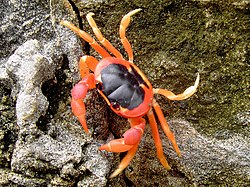



Thirty-two species of decapod crustaceans have been recorded in Dominica, an island nation in the Caribbean Lesser Antilles. This includes eighteen species of true crabs (infraorder Brachyura); three species of hermit crab; one species of porcelain crab (infraorder Anomura); and eleven species of freshwater shrimp (infraorder Caridea).
